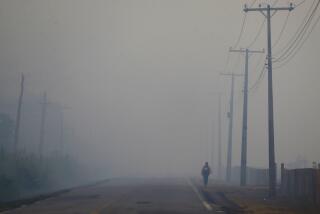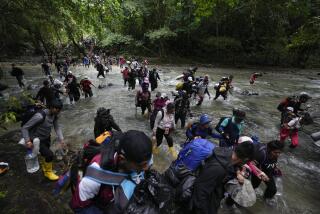Highway to Brazil, Though Badly Needed, Raises Doubts in Peru
- Share via
LIMA, Peru — Puerto Maldonado, in Peru’s southeastern Amazon region, feels like the end of the road. In this hot, dusty town 500 miles east of Lima, young men on motorbikes scour the streets looking for taxi fares.
Cars cannot handle the dirt-and-pebble roads. Small motor boats ferry passengers across the Madre de Dios River, a tributary of the Amazon. Beyond it, a trail leads 150 miles north through the jungle to the border crossing with Brazil.
Within two years, this backwater will be at the center of South America’s most important road. Last week, construction finally began on the Peru-Brazil transcontinental highway, a 40-year-old plan to connect the Atlantic to the Pacific.
The ambitious project has a price tag of almost $900 million. That may prove conservative, but the highway is desperately needed on a continent with a lack of good infrastructure. It will connect roads in Peru to a modern highway across Brazil.
The road will run through Puerto Maldonado, transforming it from a jungle outpost to a hub of an international highway system. The crowning glory will be a new 2,360-foot bridge, the largest in South America, over the Madre de Dios.
Although the construction will take place in Peru, Brazil will benefit most. The political impetus has come from Brasilia and the highway will be built by two Brazilian-led consortia.
Brazil sends 18% of its exports to Asia, and its soy and wood pulp industries want to reduce transport costs bloated by the need either to ship exports from Atlantic ports or truck them to Chile. “This road will be Brazil’s Panama Canal,” said Alejandro Indacochea of the Centrum business school in Lima.
Peru is taking on $800 million in debt to help fund the project, prompting many Peruvians to ask whether they too will benefit.
Primarily, Peru will get a modern road link between the southern Amazon and the coast. Madre de Dios is Peru’s most isolated region. The highway should help to lower prices and export costs.
Tourism in the southern Amazon will be boosted by a proper road to Cusco, next to tourist mecca Machu Picchu. In the long term, the road may attract Asian investment in Peru’s degraded southern ports, where the highway will terminate.
But there is much skepticism in Peru, even within government.
“The expectation is that there will be big traffic from Brazil to our ports, but there really are no numbers,” said Pedro Pablo Kuczynski, finance minister.
Eyebrows were raised when, for political reasons, the project was hurried through Peru’s byzantine bureaucracy, bypassing the normal channels that assess the economic benefits of public spending. “That has generated justifiable doubts about the road’s economic and environmental viability,” wrote Eduardo Zegarra, a columnist, in the Peru 21 newspaper last month.
The Peruvian government claims that the project will create 70,000 jobs. Even if that estimate is not wildly optimistic, the jobs are likely to be short-term.
With heavy traffic, even well-built jungle roads deteriorate rapidly, and locals are concerned about private contractors’ long-term commitment. They doubt public funds would be dedicated to the road’s upkeep: With 150,000 inhabitants, the Madre de Dios region is not considered politically important in Lima.
Jose de la Rosa, Madre de Dios’ acting president, plays down environmental concerns, noting that the construction will merely upgrade existing roads. But this ignores traffic pollution, illegal logging and the clearing of forest for agriculture.
The road is certain to spur the growth of Puerto Maldonado, whose population has doubled to 80,000 in the last decade.
Carlos Mateo, head of Madre de Dios’ chamber of commerce, says the region’s authorities have no plan for sustainable local development: “Brazil is much more prepared for this project.”
More to Read
Sign up for Essential California
The most important California stories and recommendations in your inbox every morning.
You may occasionally receive promotional content from the Los Angeles Times.













